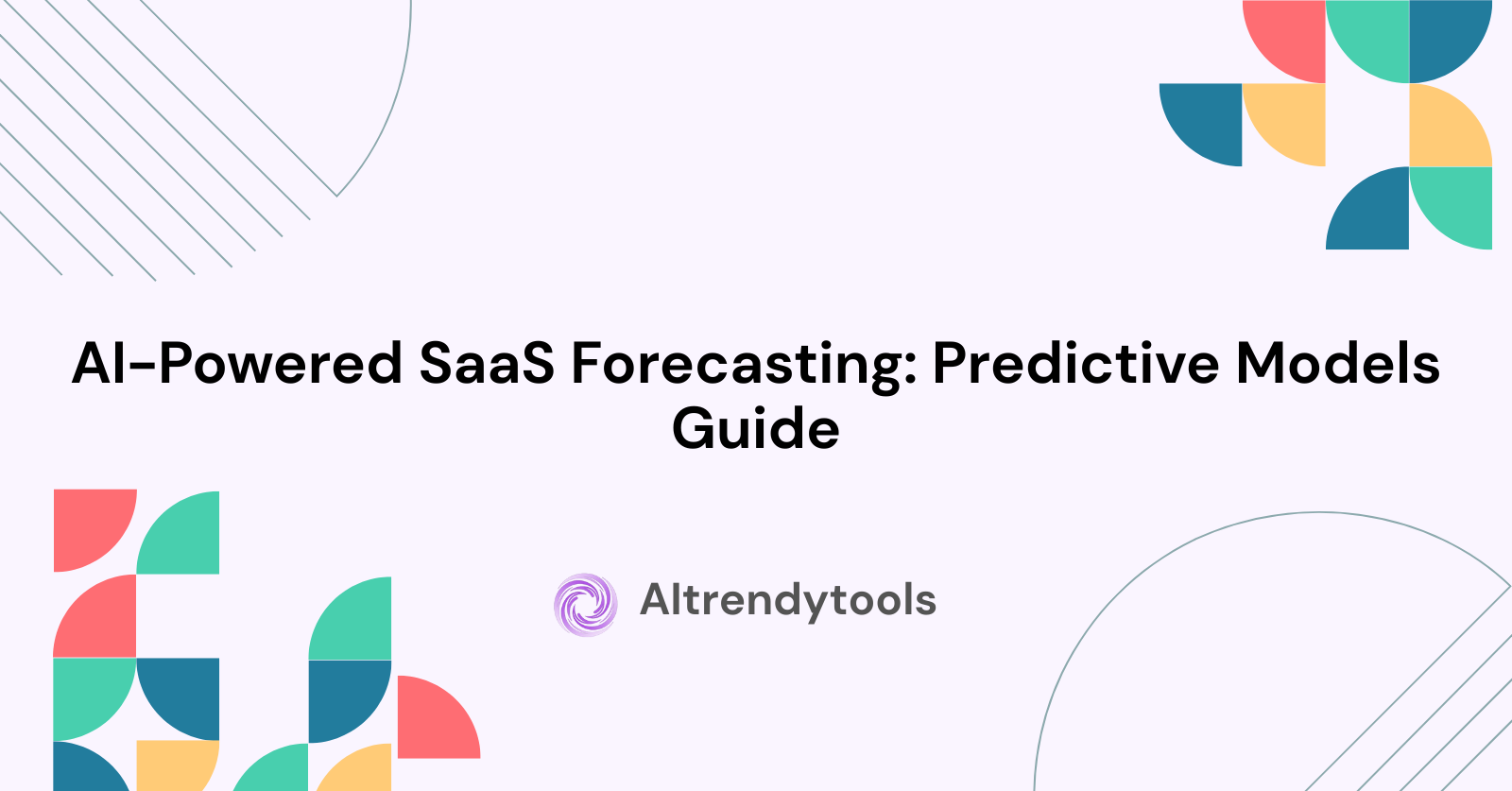🔥 AITrendytools: The Fastest-Growing AI Platform |
Write for usAI-Powered SaaS Forecasting: Predictive Models Guide
Discover how AI-powered predictive models transform SaaS forecasting. Learn machine learning techniques for accurate revenue predictions and decisions.
Oct 3, 2025
AI-Powered SaaS Forecasting: How Predictive Models Drive Smarter Decisions
Revenue forecasting remains one of the most challenging aspects of running a SaaS business. Traditional methods often fall short in today's dynamic market environment. Manual spreadsheets and gut-feeling predictions no longer deliver the accuracy needed for strategic planning. AI-powered forecasting transforms this landscape by bringing precision and intelligence to financial predictions.
Businesses now leverage machine learning algorithms to analyze vast amounts of historical data. These systems identify patterns that human analysts might miss. The technology processes multiple variables simultaneously, from customer behavior to market trends. This capability enables companies to make informed decisions based on real-time insights rather than outdated assumptions.
Understanding Predictive Analytics in SaaS
Predictive analytics uses historical data and statistical algorithms to forecast future outcomes. The technology has become essential for SaaS companies managing complex subscription models. Machine learning models examine patterns in customer acquisition, retention rates, and revenue streams.
These systems process information from multiple sources including sales transactions and customer interactions. The analysis reveals trends that inform strategic decisions. Companies gain visibility into potential challenges before they impact business performance. This proactive approach replaces reactive problem-solving with strategic planning.
Data quality determines the effectiveness of predictive models. Organizations must collect clean, consistent information across all touchpoints. The algorithms require comprehensive datasets to generate reliable forecasts. Investment in data infrastructure pays dividends through improved prediction accuracy.
Machine Learning Models for Revenue Forecasting
Different machine learning techniques serve specific forecasting needs. Time-series analysis examines historical patterns to predict future values. This method works well for subscription-based revenue models with consistent billing cycles. The algorithms identify seasonal trends and growth patterns automatically.
Regression analysis determines relationships between variables affecting revenue. Companies discover which factors most significantly impact financial performance. This understanding enables targeted improvements in areas that drive growth. The models continuously refine predictions as new data becomes available.
Neural networks handle complex, non-linear relationships in large datasets. These advanced systems excel at processing multiple variables simultaneously. They adapt to changing market conditions without manual reconfiguration. The technology proves particularly valuable for businesses with diverse product lines or customer segments.
Ensemble methods combine multiple algorithms to improve forecast accuracy. This approach leverages the strengths of different techniques while minimizing individual weaknesses. The result is more robust predictions that account for various scenarios. Many successful implementations use ensemble approaches for critical business forecasts.
Real-Time Data Analysis and Business Intelligence
Modern forecasting systems analyze data as it arrives rather than in periodic batches. This real-time processing provides current insights for immediate decision-making. Sales teams access updated predictions throughout each quarter. Leadership makes resource allocation decisions based on the latest information.
Integration with business intelligence platforms creates comprehensive visibility. Teams view forecasts alongside operational metrics and performance indicators. This unified perspective reveals connections between different business areas. Departments collaborate more effectively when working from shared data insights.
Automated reporting eliminates manual data compilation and reduces errors. Systems generate detailed analyses on demand rather than on fixed schedules. Stakeholders receive relevant information when they need it. This agility supports faster response to market changes and competitive pressures.
Customer Churn Prediction Models
Identifying customers at risk of leaving represents critical value for SaaS businesses. Predictive models analyze engagement patterns, support interactions, and usage metrics. The systems flag accounts showing concerning behavior changes. Early warnings enable proactive retention efforts before customers decide to cancel.
Behavioral signals provide insights into customer satisfaction and product fit. Declining login frequency or reduced feature usage indicate potential problems. Support ticket patterns reveal frustration or confusion. Machine learning algorithms correlate these indicators with historical churn data.
Retention strategies become more targeted when guided by predictive insights. Teams prioritize high-value accounts showing churn risk signals. Personalized outreach addresses specific concerns before they escalate. This focused approach delivers better results than generic retention campaigns.
The financial impact of improved retention is substantial. Reducing churn by even small percentages significantly affects recurring revenue. Predictive models enable companies to maximize customer lifetime value. Tools like aitrendytool help businesses implement sophisticated churn prediction without extensive data science expertise.
Demand Forecasting and Resource Allocation
Accurate demand predictions optimize operational efficiency across the organization. Infrastructure teams provision server capacity based on anticipated usage patterns. This balance prevents both over-provisioning waste and performance degradation. Companies maintain service quality while controlling costs.
Customer support staffing aligns with predicted ticket volumes and complexity. Managers schedule resources to match expected demand fluctuations. This planning reduces wait times during peak periods. Employees experience more manageable workloads with proper capacity planning.
Product development prioritizes features that forecasts indicate will drive adoption. Engineering resources focus on improvements with the highest projected impact. Marketing campaigns launch when models predict optimal receptivity. This coordination maximizes return on investment across business functions.
Financial planning benefits from reliable demand forecasts extending multiple quarters ahead. Organizations make confident commitments regarding hiring, office space, and capital investments. Strategic partnerships and vendor negotiations proceed with clearer understanding of future needs. Board presentations include data-backed projections rather than speculative estimates.
Sales Pipeline Management with AI
Sales forecasting moves beyond simple win probability calculations to comprehensive pipeline analysis. AI systems evaluate deal characteristics, prospect behavior, and historical conversion patterns. Each opportunity receives a dynamic score that updates as circumstances change. Representatives prioritize efforts based on likely outcomes.
Deal velocity metrics reveal bottlenecks in the sales process. Machine learning identifies stages where opportunities stall or fail. Management implements targeted improvements to accelerate pipeline flow. The continuous optimization increases overall sales efficiency.
Territory and quota planning leverages predictive insights about market potential. Leaders allocate resources to areas with the highest probability of success. Individual targets align with realistic projections rather than arbitrary historical figures. This fairness improves team morale and performance.
Integration with customer relationship management systems creates seamless workflows. Sales professionals access AI insights within their existing tools. Adoption increases when predictions augment rather than replace familiar processes. The technology enhances human judgment rather than attempting to automate relationship-building.
Marketing Campaign Optimization
Predictive models identify which prospects are most likely to convert at each funnel stage. Marketing teams tailor messaging to resonate with specific audience segments. Budget allocation shifts toward channels delivering the best predicted return. This precision reduces customer acquisition costs while improving quality.
Campaign timing optimizes based on historical response patterns and current market conditions. Launch dates align with periods of maximum receptivity. Content strategy adjusts to emerging trends before competitors react. The agility creates competitive advantages in crowded markets.
Attribution modeling clarifies which touchpoints contribute most to conversions. Organizations understand the customer journey with unprecedented detail. Investment decisions rest on evidence rather than assumptions about marketing effectiveness. Channels receive appropriate credit for their role in revenue generation.
A/B testing becomes more powerful when combined with predictive analytics. Systems recommend variations likely to perform well based on past experiments. Learning accumulates across campaigns rather than starting fresh each time. The compound effect accelerates marketing optimization over time.
Financial Planning and Budgeting
Annual budgeting processes benefit from data-driven revenue projections. Finance teams build models reflecting realistic growth scenarios. Department budgets align with predicted resource needs rather than political negotiations. This transparency improves trust and accountability across the organization.
Cash flow forecasting prevents surprises that strain operational capacity. Companies anticipate funding needs well in advance. Investment opportunities receive evaluation against reliable financial projections. Strategic initiatives proceed with confidence about resource availability.
Variance analysis compares actual results against predicted outcomes. Organizations learn from discrepancies to improve future forecasts. This continuous refinement enhances model accuracy over time. The feedback loop creates increasingly reliable predictions.
Scenario planning explores multiple potential futures based on different assumptions. Leadership prepares contingency plans for various market conditions. This preparedness enables rapid response when circumstances change. The organization becomes more resilient to uncertainty.
Implementation Strategies for Predictive Models
Successful implementation begins with clearly defined business objectives. Organizations identify specific problems that predictive analytics should address. This clarity guides technology selection and model development. Vague goals lead to unfocused projects that fail to deliver value.
Data infrastructure must support the volume and variety of information required. Systems capture relevant metrics consistently across all business areas. Integration between platforms eliminates information silos. Clean data flows automatically to forecasting systems.
Cross-functional collaboration ensures predictions align with operational reality. Data scientists work closely with business domain experts. This partnership creates models that reflect actual processes and constraints. The resulting forecasts earn trust from decision-makers.
Pilot projects demonstrate value before full-scale rollout. Teams test predictions in controlled environments with measurable outcomes. Success builds momentum and organizational buy-in. Lessons learned inform broader implementation strategies.
Training empowers users to interpret and apply predictive insights effectively. Organizations explain what models can and cannot do reliably. This education prevents both over-reliance on automation and dismissal of valid predictions. The human-AI partnership becomes more productive over time.
Measuring Forecast Accuracy and Model Performance
Quantitative metrics evaluate how well predictions match actual results. Mean absolute error measures the average magnitude of prediction mistakes. Root mean square error penalizes larger errors more heavily. These statistics enable objective comparison between different models.
Businesses track forecast accuracy over time to identify trends. Improving accuracy indicates successful model refinement. Declining performance signals the need for retraining or revised approaches. Regular monitoring prevents gradual degradation from going unnoticed.
Directional accuracy matters as much as precise numerical predictions. Knowing revenue will increase or decrease informs many decisions even without exact figures. Models that correctly predict trends deliver significant value. Perfect precision remains unrealistic given market complexity.
Confidence intervals communicate the uncertainty inherent in predictions. Decision-makers understand the range of likely outcomes rather than treating forecasts as certain. This transparency supports better risk assessment. Organizations avoid overconfidence based on single-point estimates.
Industry-Specific Applications
Retail businesses leverage predictive analytics for inventory optimization and seasonal planning. Models forecast product demand across multiple locations and channels. This precision reduces both stockouts and excess inventory costs. Pricing strategies adjust dynamically based on predicted demand elasticity.
Healthcare organizations predict patient volumes and resource utilization. Hospitals staff appropriately for anticipated admission patterns. Equipment maintenance schedules align with projected usage. These efficiencies improve patient care while controlling costs.
Financial services firms use predictive models for risk assessment and fraud detection. Credit decisions incorporate sophisticated analyses of repayment probability. Investment strategies benefit from market trend predictions. The technology enhances both profitability and regulatory compliance.
Manufacturing companies forecast production needs and supply chain requirements. Just-in-time strategies rely on accurate demand predictions. Maintenance schedules prevent equipment failures before they occur. Operations achieve greater efficiency through data-driven planning.
Overcoming Common Implementation Challenges
Data quality issues represent the most frequent obstacle to successful deployment. Organizations must establish processes for cleaning and validating information. Automated quality checks catch problems before they corrupt forecasts. Investment in data governance pays long-term dividends.
Resistance to change slows adoption when stakeholders distrust algorithmic predictions. Communication explains how AI augments rather than replaces human expertise. Early wins demonstrate value to skeptical team members. Transparent processes build confidence in model outputs.
Technical complexity can overwhelm organizations without data science expertise. Platforms like aitrendytool provide accessible interfaces for non-technical users. Pre-built models address common business needs without custom development. Cloud-based solutions eliminate infrastructure management burden.
Integration with legacy systems requires careful planning and execution. APIs enable data exchange between old and new platforms. Phased migration reduces disruption to ongoing operations. The transition period tests both systems running in parallel.
Future Trends in AI-Powered Forecasting
Natural language processing will enable conversational interaction with forecasting systems. Business users will ask questions in plain English rather than writing complex queries. This accessibility democratizes data-driven decision-making across organizations. Technical barriers to insight generation diminish significantly.
Automated machine learning will simplify model development and maintenance. Systems will select optimal algorithms based on data characteristics and business objectives. This automation reduces the need for specialized data science talent. Small businesses gain access to sophisticated capabilities previously available only to large enterprises.
Explainable AI addresses concerns about "black box" predictions. New techniques reveal which factors drive specific forecasts. This transparency builds trust and enables more informed decision-making. Regulatory compliance becomes easier when model logic is clear.
Integration with Internet of Things devices expands available data sources. Sensors provide real-time information about product usage and customer behavior. This granular insight enhances prediction accuracy. Business models evolve based on deeper understanding of customer needs.
Edge computing enables prediction generation closer to data sources. Reduced latency supports real-time decision-making in time-sensitive applications. Privacy-sensitive information remains local rather than transmitting to central servers. This architecture addresses both performance and security concerns.
Building a Data-Driven Culture
Leadership commitment sets the tone for organizational transformation. Executives must champion data-driven decision-making throughout the company. Resource allocation signals the importance of analytical capabilities. Consistent messaging reinforces the priority of objective evidence over intuition.
Training programs build analytical literacy across all departments. Employees learn to interpret data visualizations and statistical concepts. This shared language improves communication and collaboration. Teams make better decisions when everyone understands the evidence.
Incentive structures reward data-informed choices and penalize reliance on unsupported assumptions. Performance evaluations consider how well managers use available insights. This alignment encourages adoption of predictive tools. Cultural change accelerates when behaviors connect to rewards.
Experimentation is encouraged as a method for continuous improvement. Organizations test hypotheses rigorously rather than implementing untested ideas. Failures provide learning opportunities rather than reasons for blame. This psychological safety promotes innovation.
Selecting the Right Forecasting Tools
Evaluation criteria should prioritize ease of use alongside technical capabilities. Complex systems remain unused if they require extensive training. Intuitive interfaces encourage adoption across the organization. User experience directly impacts return on investment.
Integration requirements vary based on existing technology infrastructure. Cloud-native solutions offer faster deployment and automatic updates. On-premises systems provide greater control over data security. Hybrid approaches balance these competing considerations.
Vendor stability and support quality affect long-term satisfaction. Established providers offer resources for troubleshooting and optimization. Community forums and documentation accelerate problem resolution. Total cost of ownership includes ongoing support needs.
Scalability ensures systems grow with business needs. Solutions should handle increasing data volumes without performance degradation. Additional users and use cases should not require complete reimplementation. Flexible pricing models accommodate changing requirements.
Customization capabilities allow adaptation to unique business processes. Generic tools may not address industry-specific needs. Configuration options enable tailored workflows. The balance between flexibility and simplicity varies by organization.
Conclusion
AI-powered forecasting represents a fundamental shift in how SaaS businesses approach planning and decision-making. The technology delivers unprecedented accuracy through sophisticated analysis of complex datasets. Organizations gain visibility into future trends that inform strategic choices across all departments.
Implementation success requires commitment to data quality and cultural change. Technical capabilities mean little without organizational readiness to act on insights. The journey toward predictive excellence proceeds in stages with measurable milestones.
Competitive advantages accrue to early adopters who master these capabilities. Markets reward companies that anticipate customer needs and optimize operations. The gap between leaders and laggards widens as AI maturity increases.
The future belongs to organizations that combine human judgment with machine intelligence. Neither approach alone delivers optimal results in complex business environments. Partnership between people and algorithms creates possibilities exceeding what either achieves independently. Investment in predictive capabilities positions companies for sustained success in an increasingly data-driven world.
🚀 Submit Your Tool to Our Comprehensive AI Tools Directory
Get your AI tool featured on our complete directory at AITrendytools and reach thousands of potential users. Select the plan that best fits your needs.





Join 30,000+ Co-Founders
Related Blogs
DreamFace: #1 AI Face Generator for Realistic Photos
Discover DreamFace, the leading AI face generator creating ultra-realistic portraits. Free & premium tools for creators, gamers & professionals. Try now!
TechMapz Com: 7 Reasons It's Your Best Tech Hub
Discover TechMapz com the ultimate technology hub for gadget reviews, AI trends, cybersecurity tips, and tech news. Explore features that make it stand out in 2025.
Sci Hub: 10+ Free Alternatives to Access Research Papers
Discover Sci Hub alternatives and 10+ legal ways to access research papers free. Complete guide to scientific journals, open access, and academic resources.
Submit Your Tool to Our Comprehensive AI Tools Directory
List your AI tool on AItrendytools and reach a growing audience of AI users and founders. Boost visibility and showcase your innovation in a curated directory of 30,000+ AI apps.





Join 30,000+ Co-Founders

